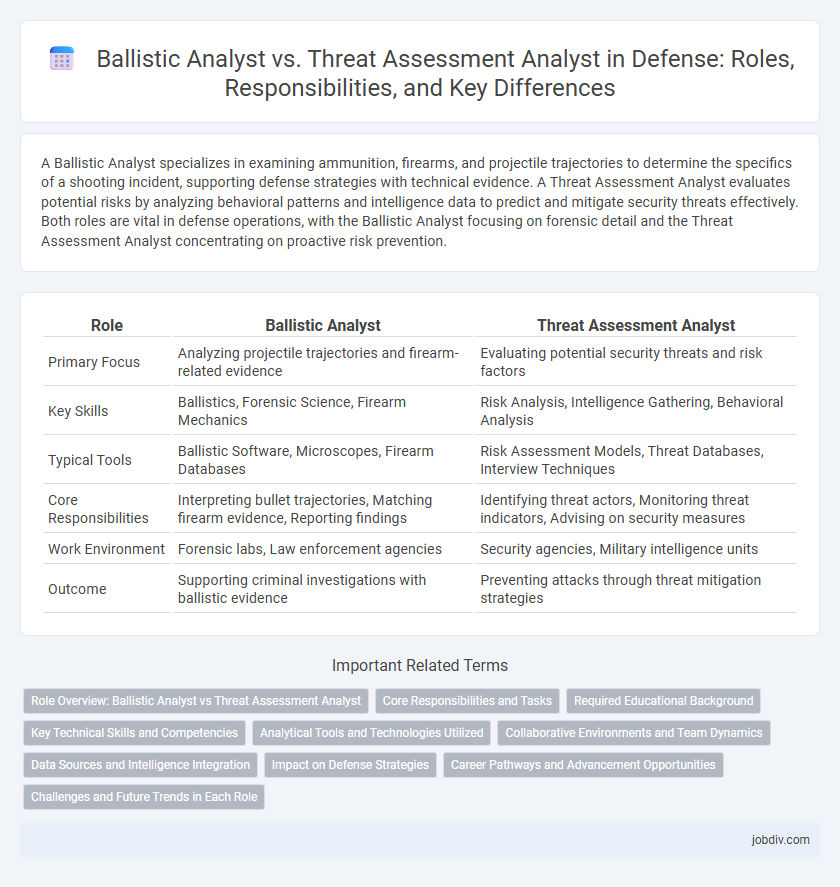A Ballistic Analyst specializes in examining ammunition, firearms, and projectile trajectories to determine the specifics of a shooting incident, supporting defense strategies with technical evidence. A Threat Assessment Analyst evaluates potential risks by analyzing behavioral patterns and intelligence data to predict and mitigate security threats effectively. Both roles are vital in defense operations, with the Ballistic Analyst focusing on forensic detail and the Threat Assessment Analyst concentrating on proactive risk prevention.
Table of Comparison
| Role | Ballistic Analyst | Threat Assessment Analyst |
|---|---|---|
| Primary Focus | Analyzing projectile trajectories and firearm-related evidence | Evaluating potential security threats and risk factors |
| Key Skills | Ballistics, Forensic Science, Firearm Mechanics | Risk Analysis, Intelligence Gathering, Behavioral Analysis |
| Typical Tools | Ballistic Software, Microscopes, Firearm Databases | Risk Assessment Models, Threat Databases, Interview Techniques |
| Core Responsibilities | Interpreting bullet trajectories, Matching firearm evidence, Reporting findings | Identifying threat actors, Monitoring threat indicators, Advising on security measures |
| Work Environment | Forensic labs, Law enforcement agencies | Security agencies, Military intelligence units |
| Outcome | Supporting criminal investigations with ballistic evidence | Preventing attacks through threat mitigation strategies |
Role Overview: Ballistic Analyst vs Threat Assessment Analyst
Ballistic Analysts specialize in examining projectiles, firearms, and ammunition to provide detailed forensic information on shooting incidents, supporting criminal investigations and military operations. Threat Assessment Analysts evaluate potential security risks by analyzing behavioral patterns, intelligence reports, and environmental factors to predict and prevent hostile actions against personnel or infrastructure. Both roles are critical in defense strategies, with Ballistic Analysts focusing on physical evidence analysis and Threat Assessment Analysts emphasizing anticipatory risk evaluations.
Core Responsibilities and Tasks
Ballistic Analysts specialize in examining firearm-related evidence, such as bullet trajectories, cartridge casings, and gunshot residue, to reconstruct shooting incidents and identify weapons used. Threat Assessment Analysts focus on evaluating potential dangers by analyzing behavioral patterns, intelligence reports, and situational data to predict and mitigate risks to individuals or organizations. Both roles require collaboration with law enforcement and military units, but Ballistic Analysts emphasize forensic science while Threat Assessment Analysts prioritize psychological and intelligence analysis.
Required Educational Background
Ballistic Analysts typically require a background in forensic science, physics, or engineering, often holding a bachelor's degree in these fields to understand projectile trajectories and gunshot residue analysis. Threat Assessment Analysts usually possess degrees in criminal justice, psychology, or homeland security, emphasizing skills in behavioral analysis and risk evaluation. Both roles benefit from specialized training and certifications related to law enforcement and intelligence analysis to enhance their expertise in defense operations.
Key Technical Skills and Competencies
Ballistic Analysts specialize in forensic examination of projectile trajectories and firearm mechanics, requiring expertise in ballistics software, microscopy, and materials analysis. Threat Assessment Analysts focus on identifying and evaluating potential security risks, necessitating proficiency in intelligence gathering, behavioral analysis, and risk management frameworks. Both roles demand analytical thinking, attention to detail, and strong communication skills to interpret complex data and provide actionable insights for defense operations.
Analytical Tools and Technologies Utilized
Ballistic analysts utilize sophisticated forensic technologies such as 3D imaging, ballistics comparison microscopes, and computer-aided trajectory analysis software to examine firearm projectiles and cartridge cases for evidentiary connections. Threat assessment analysts employ advanced intelligence platforms, predictive analytics, and behavioral modeling tools to evaluate potential risks and identify security threats in various operational environments. Both roles integrate geographic information systems (GIS) and data mining techniques to enhance situational awareness and support strategic defense decision-making.
Collaborative Environments and Team Dynamics
Ballistic Analysts specialize in examining projectile trajectories and firearm evidence, providing precise data critical for understanding incident specifics within defense investigations. Threat Assessment Analysts evaluate behavioral patterns and potential risks from individuals or groups, informing proactive security measures and strategic planning. In collaborative environments, these roles complement each other by integrating technical ballistics insights with comprehensive threat evaluations, fostering enhanced team dynamics through multidisciplinary expertise and coordinated communication.
Data Sources and Intelligence Integration
Ballistic Analysts primarily utilize forensic data from crime scenes, firearms databases, and ballistic evidence repositories to reconstruct projectile trajectories and identify weapon characteristics. Threat Assessment Analysts integrate diverse intelligence sources, including human intelligence (HUMINT), signals intelligence (SIGINT), and open-source intelligence (OSINT), to evaluate potential risks and identify threats. The convergence of ballistic data with multi-intelligence inputs enhances comprehensive threat characterization and operational decision-making in defense scenarios.
Impact on Defense Strategies
Ballistic Analysts provide critical data on projectile trajectories and weapon capabilities, directly influencing defense strategies by enabling precise countermeasures and improved missile defense systems. Threat Assessment Analysts evaluate potential risks from hostile entities and emerging technologies, shaping strategic priorities and resource allocation to mitigate vulnerabilities. Together, their insights enhance the comprehensive defense posture by integrating technical weapon analysis with broader security threat evaluations.
Career Pathways and Advancement Opportunities
Ballistic analysts specialize in examining firearm-related evidence, utilizing forensic techniques to reconstruct shooting incidents and support criminal investigations, which often leads to advanced roles in forensic laboratories or federal agencies like the ATF or FBI. Threat assessment analysts focus on evaluating potential risks posed by individuals or groups through behavioral analysis, intelligence gathering, and risk management, creating career pathways toward positions in homeland security, law enforcement leadership, or private sector security consulting. Both career tracks offer advancement opportunities through specialized certifications, experience in high-profile cases, and interdisciplinary collaboration to enhance national security and crime prevention efforts.
Challenges and Future Trends in Each Role
Ballistic Analysts face challenges in interpreting complex trajectory data amid evolving projectile technologies, requiring advances in computational modeling and real-time data processing. Threat Assessment Analysts confront difficulties in synthesizing multidimensional intelligence sources to predict emerging security risks, demanding enhanced AI-driven analytics and adaptive risk frameworks. Future trends include increased integration of machine learning algorithms in ballistic simulations and dynamic threat modeling to improve accuracy and responsiveness in defense operations.
Ballistic Analyst vs Threat Assessment Analyst Infographic

 jobdiv.com
jobdiv.com